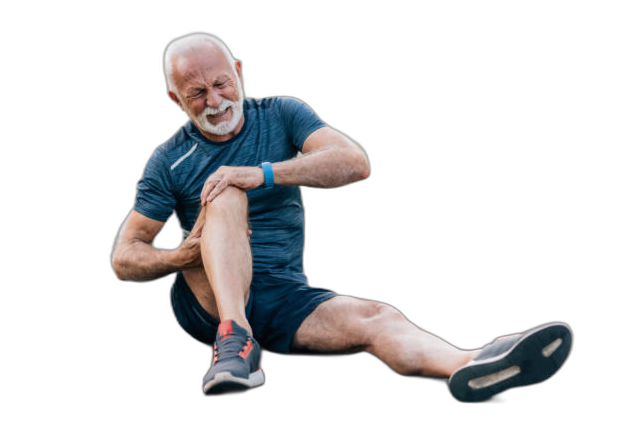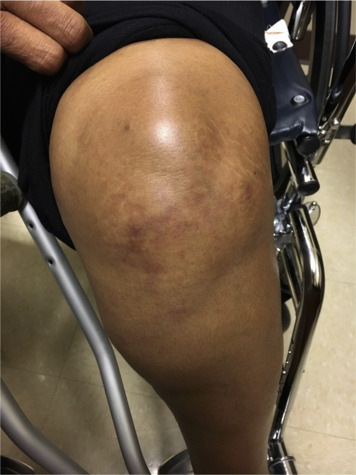Life with Knee Pain: A Daily Struggle
Knee pain is a common ailment that affects millions of people worldwide. It can arise from various causes such as injury, arthritis, overuse, or underlying medical conditions. Living with knee pain significantly impacts an individual’s quality of life, limiting mobility, causing discomfort, and affecting daily activities. This essay explores the physical, emotional, and social aspects of life with knee pain, shedding light on the challenges faced by those who endure this persistent condition.

Physical Challenges
Life with knee pain is characterized by physical limitations and challenges. Simple tasks like walking, climbing stairs, or standing for extended periods become arduous endeavors. The constant knee pain caused by, stiffness, and swelling of joints often restrict mobility and hinder one’s ability to engage in physical activities they once enjoyed. The pain can range from mild discomfort to excruciating, impacting sleep patterns and causing fatigue. Individuals may find themselves dependent on mobility aids such as crutches or canes, further adding to feelings of frustration and limitations in independence.

Emotional Impact
The emotional toll of living with knee pain should not be overlooked. Chronic and severe joint pain can lead to feelings of sadness, frustration, and helplessness. The constant discomfort and limitations common knee injuries can result in a loss of confidence and self-esteem. Depression and anxiety often accompany long-term pain, as individuals grapple with the constant burden and uncertainty of their condition. The inability to participate in activities they once loved can lead to a sense of isolation and a loss of identity, contributing to a diminished overall quality of life.
Social Implications
Knee pain not only affects individuals physically and emotionally but also has profound social implications. Social activities and gatherings that involve standing or walking may be avoided, leading to a sense of exclusion and isolation. The fear of being a burden on others or being unable to keep up with the pace of social engagements may lead to withdrawal from social interactions. Furthermore, individuals with knee joint may find it challenging to maintain employment or engage in certain professions that require physical agility, resulting in financial strain and decreased opportunities for personal growth.

Coping Mechanisms
Despite the challenges posed by knee pain, individuals develop coping mechanisms to manage their condition. Pain management techniques such as medications, physical therapy, and alternative treatments like acupuncture or heat therapy can provide temporary relief relieve knee pain. Additionally, engaging in low-impact exercises such as swimming or cycling can help strengthen the surrounding muscles and improve overall knee function. Assistive devices like knee braces or orthotic shoes may offer support and stability. Seeking emotional support through therapy or support groups can also play a vital role in managing the physical therapist emotional toll of knee pain.

The Importance of Medical Intervention
Seeking medical intervention is crucial for individuals living with knee pain. Proper diagnosis by healthcare professionals can identify the underlying cause of the pain and guide appropriate treatment strategies. Treatment options for arthritis pain may include medications, corticosteroid injections, physical therapy, or surgical interventions in severe cases. Physicians may also recommend lifestyle modifications such as weight management, exercise, and adopting joint-friendly practices to alleviate pain and prevent further damage. Regular follow-ups with healthcare providers are essential to monitor progress, adjust treatment plans, and ensure optimal joint pain and management.

Adapting to a New Normal
Living with knee pain requires individuals to adapt to a new normal. Accepting limitations and making necessary adjustments in daily life become crucial for maintaining functionality and emotional well-being. Simple modifications, such as using assistive devices, installing handrails, or rearranging furniture for accessibility, can make a significant difference. Prioritizing self-care, including managing weight, maintaining a balanced diet, and engaging in gentle exercises, can help manage and reduce pain, and improve overall knee health. Engaging in activities that do not exacerbate knee pain, such as low-impact exercises or hobbies that can be enjoyed seated both knees, can provide a sense of fulfillment and purpose.
Our Thoughts
Life with knee pain presents numerous challenges that encompass physical, emotional, and social aspects. The constant pain, limitations in mobility, and the impact on daily activities can be overwhelming. It is essential for individuals with knee injury to seek appropriate medical intervention to manage the pain and identify the underlying causes of minor injury. Implementing coping mechanisms and lifestyle modifications can help alleviate discomfort and improve overall knee health. Emotionally, it is important to address the psychological impact of chronic pain through therapy or support groups. Socially, maintaining connections and seeking support from loved ones can help combat feelings of isolation.
Living with knee pain requires resilience and adaptability. It may entail adjusting expectations and finding alternative ways to rest or engage in activities that bring joy and fulfillment. While knee pain may be a lifelong condition, with proper management and care, individuals can regain a sense of control over their lives and pursue a meaningful existence.
It is important to raise awareness about knee pain and its impact on individuals’ lives. Healthcare professionals should strive to provide comprehensive care, focusing not only on physical treatment and surgery to relieve pain, but also addressing emotional well-being and social support. Continued research and advancements in medical technology can lead to improved treatments and interventions for individuals living with knee pain.
Ultimately, with a holistic approach to managing knee and joint pain, individuals can find ways to lead fulfilling lives, pursuing their passions and maintaining connections with others. Though the journey to pain relief may be challenging, it is possible to find hope and regain a sense of normalcy while living with knee pain.
Frequently Asked Questions
-
What is knee pain?
Answer: Knee pain refers to discomfort or soreness experienced in or around the knee joint. It can range from mild to severe and may be caused by various factors such as injury, arthritis, overuse, or underlying medical conditions.
-
What are the common causes of knee pain?
Answer: Knee pain can be caused by several factors, including ligament injuries, meniscus tears, osteoarthritis, rheumatoid arthritis, bursitis, tendonitis, and overuse injuries from activities like running or repetitive motions.
-
How does knee pain affect daily life?
Answer: Knee pain can significantly impact daily life by limiting mobility and hindering one’s ability to perform routine activities such as walking, climbing stairs, standing, or kneeling. It may also disrupt sleep patterns and cause fatigue.
-
How does knee pain affect physical activities and exercise?
Answer: Knee pain often restricts participation in physical activities and exercise. High-impact activities like running or jumping may become challenging or impossible, and even low-impact exercises may need to be modified or avoided altogether to prevent exacerbating the pain.
-
Can knee pain affect mental and emotional well-being?
Answer: Yes, knee pain can have a significant impact on mental and emotional well-being. Chronic pain can lead to feelings of frustration, sadness, and helplessness. It may also contribute to anxiety, depression, and a loss of confidence or self-esteem.
-
How does knee pain affect work or occupational activities?
Answer: Knee pain can affect work or occupational activities, particularly if the job requires physical exertion or prolonged periods of standing or walking. It may limit one’s ability to perform certain tasks, leading to decreased productivity and potential financial implications.
-
What are some strategies for managing knee pain?
Answer: Strategies for managing knee pain include rest, physical therapy, pain medications, ice or heat therapy, weight management, using assistive devices (such as knee braces or canes), and engaging in low-impact exercises to strengthen the surrounding muscles.
-
Can lifestyle modifications help alleviate knee pain?
Answer: Yes, lifestyle modifications can play a significant role in alleviating knee pain. Maintaining a healthy weight reduces stress on the knee joint, while regular exercise, particularly low-impact activities like swimming or cycling, can improve knee function and strengthen supporting muscles.
-
Are there alternative treatments for knee pain?
Answer: Yes, alternative treatments for knee pain may include acupuncture, herbal supplements, and topical creams or ointments containing anti-inflammatory ingredients. However, it is essential to consult with healthcare professionals before trying any alternative treatments.
-
When should I seek medical attention for knee pain?
Answer: It is advisable to seek medical attention for knee pain if it is severe, persistent, or accompanied by other concerning symptoms such as swelling, redness, or instability. A healthcare professional can evaluate the underlying cause, provide a proper diagnosis, and recommend appropriate treatment options for effective pain management.
